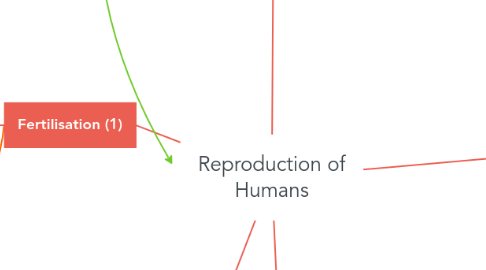
1. Fertilisation (1)
1.1. Process where the nucleus of the sperm fuses with the nucleus of the ovum to form zygote
1.1.1. 1. Penis deposits semen in the vagina
1.1.2. 2. Sperm cells swim through the cervix, into the uterus, and into the oviduct
1.1.3. 3. Sperm cells meets an egg cell in the oviduct
1.1.4. 4. Fertilisation occurs/nucleus of sperm cell fuses with the nucleus of the egg cell, other sperm dies.
2. Implantation (2)
2.1. The zygote travels to the uterus to be implanted in uterine lining of the uterus lining where it develops into a fetus
3. Menstrual Cycle
3.1. Menstruation ( Day 1-5 )
3.1.1. Uterine lining break down and are discharged through the vagina with the unfertilised egg
3.2. Ovulation ( Days 10-15 )
3.2.1. Occurs on day 14
3.2.2. Matured ovums released survive for 24 in the female reproductive system
3.2.3. Sperms deposited lives from approximately 3 - 4 days in the female reproductive system
3.2.4. Fertile period (a higher chance of fertilisation if sexual intercourse takes place)
3.3. Typical cycle lasts 28 days ranging from 23 to 40 days
3.4. Varies from one female to another as different factors affects the menstrual cycle
3.5. Implantation
3.5.1. The zygote develops into an embryo. The embryo travels down the oviduct towards the uterus. It is then implanted in the utherine lining of the uterus lining where it develops into a fetus.
4. Function
4.1. Asexual Reproduction
4.1.1. Production of new organisms from a single parent
4.1.2. New organisms produced are genetically identical to the parent
4.1.3. Occur in most unicellular organism and plants e.g. Amoeba, Potato plant
4.2. Sexual Reproduction
4.2.1. Production of new organisms from 2 parents-a male and a female
4.2.2. New organisms are not genetically identical/genetically different to the parents but inherit characteristics from both parents
4.2.3. Occur in most complex organisms e.g. Humans, Flowering Plant
5. Heredity
5.1. 23 chromosomes from sperm cell & 23 chromosomes from ovum
5.1.1. Chromosomes — carry genes in the nucleus which controls our growth and characteristics
6. Development of Zygote (3)
6.1. Cells divide into embryo and cells divide & differentiate into a fetus
6.2. Develops for 38-40 weeks (normal 39)
7. Female Reproductive Parts
7.1. Ovary
7.1.1. Produces ovum
7.1.2. Produces female sex hormones _that control sexual development in the body_
7.2. Oviduct
7.2.1. Fertilisation usually takes place here
7.2.2. Allows ovum to enter the uterus from the ovary
7.3. Uterus
7.3.1. A place where the fertilised ovum (zygote) implants itself in the uterine lining which thickens for implantation And breaks down when no fertilisation does not occurs
7.3.2. A muscular organ place where the embryo develops into a fetus during pregnancy
7.4. Cervix
7.4.1. A ring of muscled at the lower end of the uterus that widens during birth
7.5. Vagina
7.5.1. Where sperm are deposited
7.5.2. Birth canal
8. Male Reproductive Parts
8.1. Testis
8.1.1. Where sperms are produced
8.1.2. Where male sex hormones are produced _which controls the sexual development in the body_
8.2. Urethra
8.2.1. Allows sperm cells to pass through during ejaculation
8.2.2. Allows urine to be removed from the body
8.3. Sperm duct
8.3.1. Carriers sperm from testis to uterus
8.4. Penis
8.4.1. Deposits semen into the vagina during ejaculation
8.5. Sex Glands
8.5.1. Produce nutrient fluid to nourish the sperm
9. Puberty
9.1. Growth of hair in the armpits
9.2. Hips becomes broader and rounder
9.3. Height and weight increase
9.4. Maturations of ovums
9.4.1. Female sex cells
9.4.2. Largest cell in the body
9.4.3. Round/spherical
9.4.4. Cannot move by itself
9.5. Enlargement of breasts
9.6. Growth of hair in the pubic region
10. Puberty
10.1. Growth of facial hair
10.2. Enlargement of the voice box
10.3. Growth of hair in the armpits
10.4. Increase in size of the penis
10.5. Production of sperm
10.5.1. Male sex celll
10.5.2. Smallest cell in body
10.5.3. Has a head, middle piece and flagellum
10.5.4. Able to swim with the flagellum
